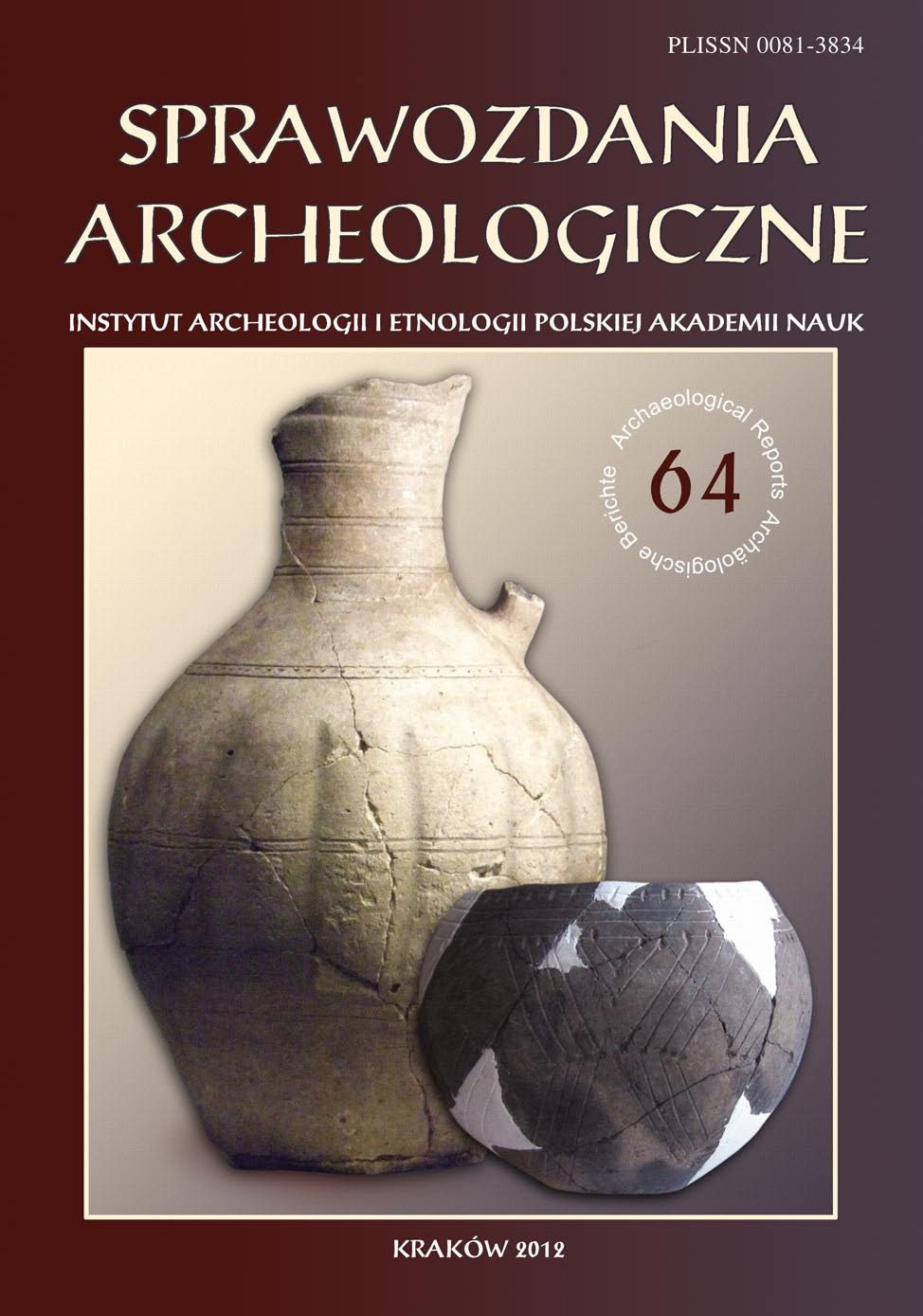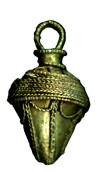Ferruginous red micro-artefacts as a source of archaeological information: a study of selected Palaeolithic sites and experimental research = Czerwone proszki żelaziste jako źródło informacji archeologicznej — na podstawie wybranych stanowisk paleolityczn
Keywords:
hematite, ochre, provenance, processing, Palaeolithic, research, archaeometry, SEM/EDS, XRD, Raman spectroscopy, FTIRAbstract
Red, cherry, orange, yellow and pink ferruginous powders have long been observed on Palaeolithic sites along with solid objects of similar material, which used to be labelled as “ochre” or “haematite”. Artefacts below 5 mm in size can carry abundant information on their provenance and processing (mixing with binders, heating, manufacturing with bone and flint tools, rubbing). Powders from selected Palaeolithic sites (Dzierżysław-35, Wierzawice, Michałów-Piaska, Klissoura, Gönnersdorf, Dolní Vĕstonice, Stadice, Monruz) were examined with X-ray diffraction, scanning microscopy, micro-chemical analysis, Raman spectroscopy and Fourier Transform Infrared Spectroscopy. A database of raw materials and archaeological ferruginous objects is under construction
Downloads
References
Berry B. 2011. Artists’ Pigments. A Handbook of their History and Characteristics 4. Washington-Oxford
Bobak D., Łańczont M., Nowak A., Połtowicz-Bobak M. and Tokarczyk S. 2010. Wierzawice, stan. 31 — nowy ślad osadnictwa magdaleńskiego w Polsce południowo-wschodniej. Materiały i Sprawozdania Rzeszowskiego Ośrodka Archeologicznego 31, 63–79
Bolewski A. and Manecki A. 1993. Mineralogia szczegółowa. Warszawa
Burtan J., Sokołowski S., Sikora W. and Żytko K. 1956. Szczegółowa Mapa Geologiczna Polski. Arkusz Milówka (1029). Warszawa
Cháb J., Stránik Z. and Eliás M. (eds.). 2007. Geologická Mapa České Republiky. Praha
Chalmin E., Menu M. and Vignaud C. 2003. Analysis of rock art painting and technology of Palaeolithic painters. Measurement Science and Technology 14, 1590–1597
Cornell R. M. and Schwertmann U. 2003. The Iron Oxides. Structure, Properties, Reactions, Occurrences and Uses. Weinheim
d’Errico F., Salomon H., Vignaud C. and Stringer C. 2010. Pigments from the Middle Palaeolithic levels of El-Skhul (Mount Carmel, Israel). Journal of Archaeological Science 37, 3099–3110
de Faria D. L. A. and Lopes F. N. 2007. Heated goethite and natural haematite: Can Raman spectroscopy be used to differentiate them? Vibrational Spectroscopy 45(2), 117-121
Dzik J. 1997. Dzieje życia na Ziemi. Warszawa
Filonowicz P. 1980. Mapa geologiczna Polski. Arkusz Kielce. Warszawa
Ginter B., Połtowicz M., Pawlikowski M., Skiba S., Trąbska J., Wacnik A., Winiarska-Kabacińska M. and Wojtal P. 2002. Dzierżysław-35 — stanowisko magdaleńskie na przedpolu Bramy Morawskiej. In J. Garncarski (ed.), Starsza i środkowa epoka kamienia w Karpatach Polskich. Krosno, 111–146
Ighilahriz F. 1996. L’ocre dans l’industrie lithique de l’Iberomauruzien d’Afalou Bou-Rhummel (Algérie). L’Anthropologie 100(1), 77–87
Kaczanowska M., Kozłowski J. K. and Sobczyk K. 2010. Upper Palaeolithic Human Occupation and Material Culture at Klissoura Cave 1. Eurasian Prehistory 7(2), 133–285
Klíma B. 1963. Dolní Věstonice. Výzkum tábořiště lovců mamutů v letech 1949–1952. Praha, 137-152
Klíma B. 1995. Dolní Vĕstonice II. Ein Mammutjägerrastplatz und seine Bestattungen (= Études et recherches archéologiques de l’Université de Liège 73; The Dolní Vĕstonice Studies 3). Liège, 1–140
Lis J. and Sylwestrzak H. 1986. Minerały Dolnego Śląska. Warszawa, 1-791
Litt T., Schmincke H-U., Frechen M. and Schlűchter C. 2008. Quarternary. In T. McCann (ed.), The Geology of Central Europe 2: Mesozoic and Cenozoic. London, 1287–1340
Łaptaś A.and Paszkowski M. 2003. Ferruginous Pigments. In P. Valde-Nowak, A. Nadachowski and T. Madeyska (eds.), Obłazowa Cave. Human activity, stratigraphy and palaeoenvironment. Kraków, 78–79
Piperno D., Weiss E., Holst I. and Nadel D. 2004. Processing of wild cereals in the Upper Palaeolithic revealed by starch grain analysis. Nature 430, 670–673
Plumettaz N. 2006. Les matériaux colorants et les pierres ocreés. In J. Bullinger, D. Leesch and N. Plumettaz (eds.), Le site magdalénien de Monruz. Premieres éléments pour l‘analyse d‘un habitat de pleine air (=Archéologie neuchâteloise 33). Nauchâtel
Pomičs M.-P., Menu M. and Vignaud C.1999. Red palaeolithic pigments: natural haematite or heated goethite? Archaeometry 41(2), 275–285
Rice P. 2005. Pottery analysis as a sourcebook. Chicago
Rosanň P. and Pelizzaro S. 2005. Analisi chimico-stratigrafico di tre pietre dipinte con ocra. In A. Broglio and G. Dalmeri (eds.), Pitture paleolitiche nelle Prealpi Venete. Grotta di Fumane e Riparo Dalmeri. Verona, 139–143
Ryka W. and Maliszewska A. 1991. Słownik petrograficzny. Warszawa, 1–415
Schild R., Królik H., Tomaszewski A. J. and Ciepielewska E. Rydno. A Stone Age Red Ochre Quarry and Socioeconomic Center. A Century of Research. Warszawa
Sulgostowska Z. 2007. Ochre among Mazovian societies. In J. Kobusiewicz and J. Kabaciński (eds.), Studies in the Final Palaeolithic Settlement of the Great European Plain. Warszawa, 175–183
Terberger T. 1997. Die Siedlungsbefunde des Magdalénien — Fundplatzes Gönnersdorf, Konzentrazion III und IV. Stuttgart
Trąbska J. 2001. Mineralogical and chemical study of painting layers of Medieval wall paintings from Poland (=Prace Mineralogiczne 90). Kraków
Trąbska J. and Gaweł A. 2007. Microstructural features of powdered haematite as a promosing factor in provenance studies. Sprawozdania Archeologiczne 59, 41-48
Trąbska J., Winiarska-Kabacińska M. and Trybalska B. 2008. Experimental skin processing with ferruginous material. Macro- and microproperties. Preliminary results. Analecta Archaeologica Ressoviensia 2, 191–209
Trąbska J. 2009. Microstructure of hematite powder: an undervalued indicator in interpretation of ferruginous raw material manufacturing, using and provenance? Śląskie Sprawozdania Archeologiczne 51, 5–13
Trąbska J., Walanus A. and Gaweł A. 2009. Outer Carpathian variegated shales — a potential red rawmaterial in Palaeolithic? In J. Gancarski (ed.), Surowce naturalne w Karpatach oraz ich wykorzystanie w pradziejach i wczesnym średniowieczu. Krosno, 193–204
Trąbska J. 2010. „Ochre” and „haematite” — database of red and yellow artefacts from the Magdalenian Dzierżysław-35 site, Upper Silesia, Poland. In M. Połtowicz-Bobak and D. Bobak (eds.), The Magdalenian in Central Europe. New Finds and Concepts (= Collectio Archaeologica Ressoviensis 15). Rzeszów, 113–120
Trąbska J., Gaweł A., Trybalska B. and Fridrichová-Sykorová I. 2010. Coloured raw materials on the Bečov I site and in the vicinity. Preliminary results and further perspectives. In Ecce homo: in memoriam Jan Fridrich. Praga, 205–218
Vandiver P. 1997. Pavlov I pigments and their processing. In J. Svoboda (ed.), Pavlov I — Northwest. The Upper palaeolithic burial and its settlement context (= The Dolní Věstonice Studies 4). Brno, 373–381
Vencl S.1991. The rescue excavation of a Gravettian site at Stadice, district Ustí-nad-Labem. Preliminary report. Archaeology in Bohemia 1986-1990. Praga, 191–193
Vencl S.1995. Hostim. Magdalenian in Bohemia. Památky Archeologicke (= Supplementum 4). Praga
Vleeskens J., Kwiecińska B., Roos M. and Hamburg G. 1994. Coke forms in nature and in power utilities: interpretation with SEM. Fuel 73(6), 816–822
Wadley L. 2005. Putting ochre to the test: replication studies of aghesives that may have been used for hafting tools in the Middle Stone Age. Journal of Human Evolution 49(5), 587–601
Watts J. 2010. The pigments from Pinacle Point Cave 13B, Western Cape, South Africa. Journal of Human Evolution 59, 392–411
Weiner S. 2010. Microarchaeology. Beyond the visible. Archaeological record. Cambridge
Wesełucha-Birczyńska A., Trąbska J., Oliva M. 2012. Composition of a floor from an Upper Palaeolithic skeletal grave – a case from Dolní Vĕstonice (Moravia, Czechia, Central Europe). Vibrational Spectroscopy 60, 129-132
kliknij tutaj, żeby przejść
XRAYAN. 2007. Powder Diffractometry Data Handling System, version 4.0.5
Downloads
Published
How to Cite
Issue
Section
License

This work is licensed under a Creative Commons Attribution-NonCommercial-NoDerivatives 4.0 International License.














